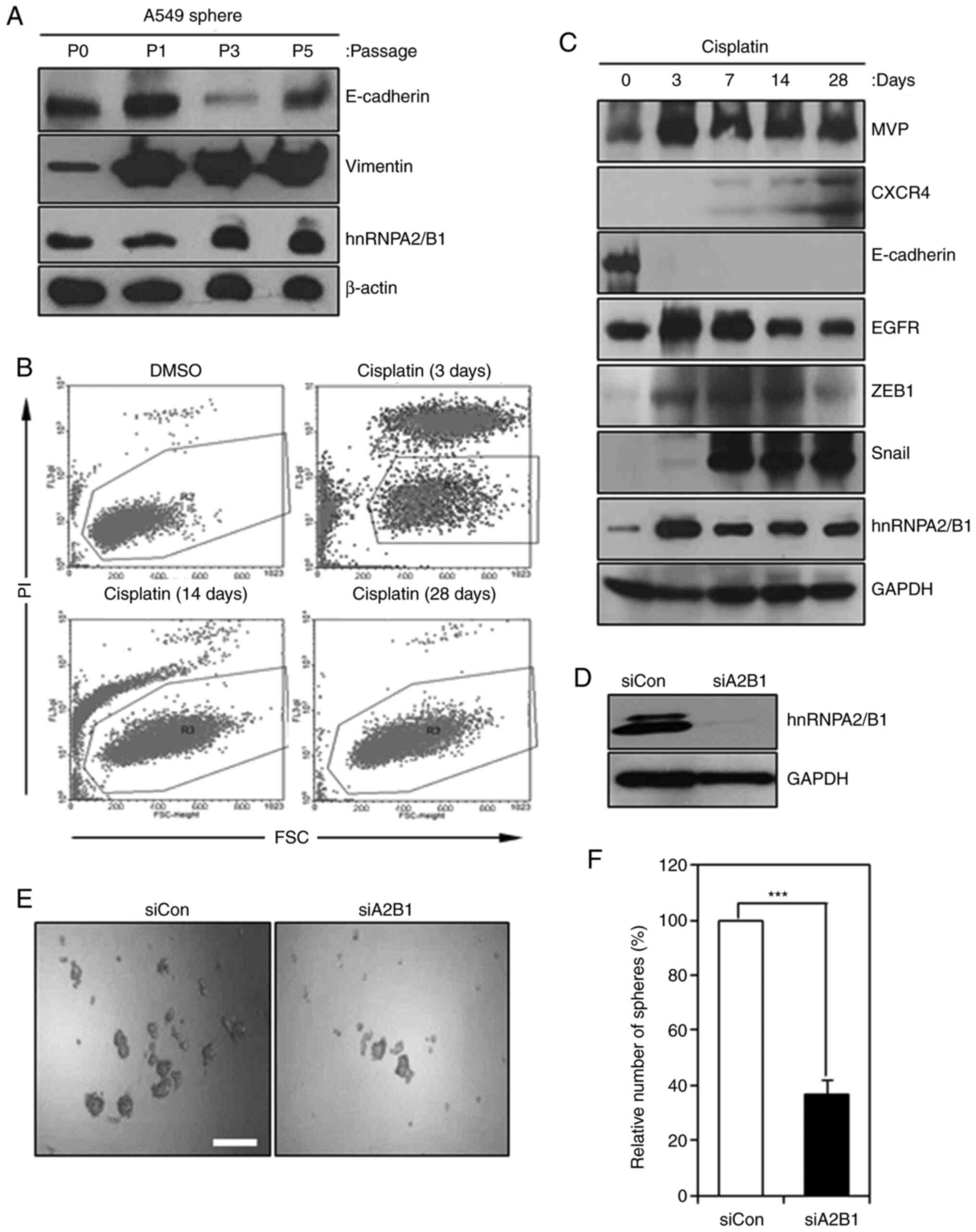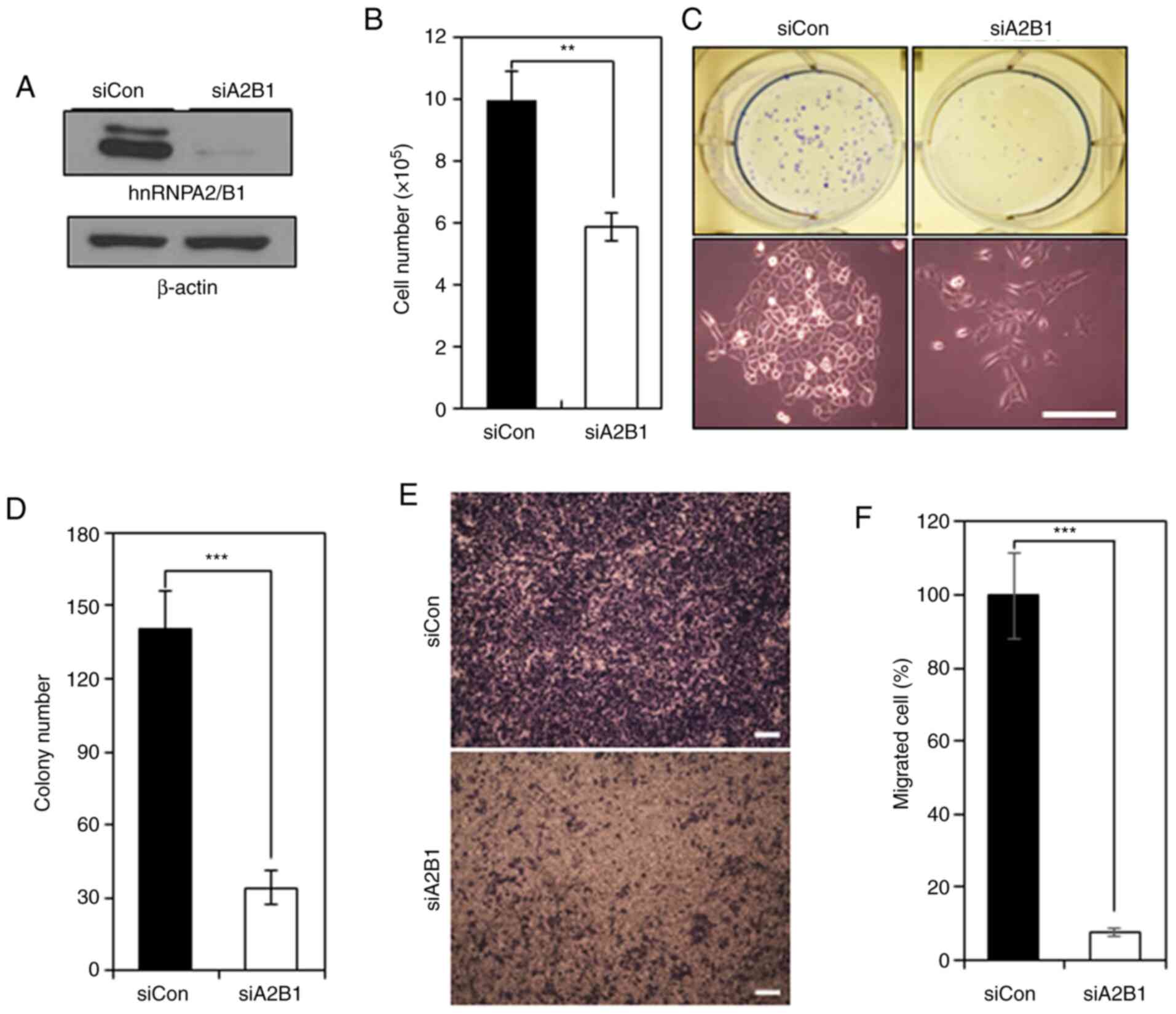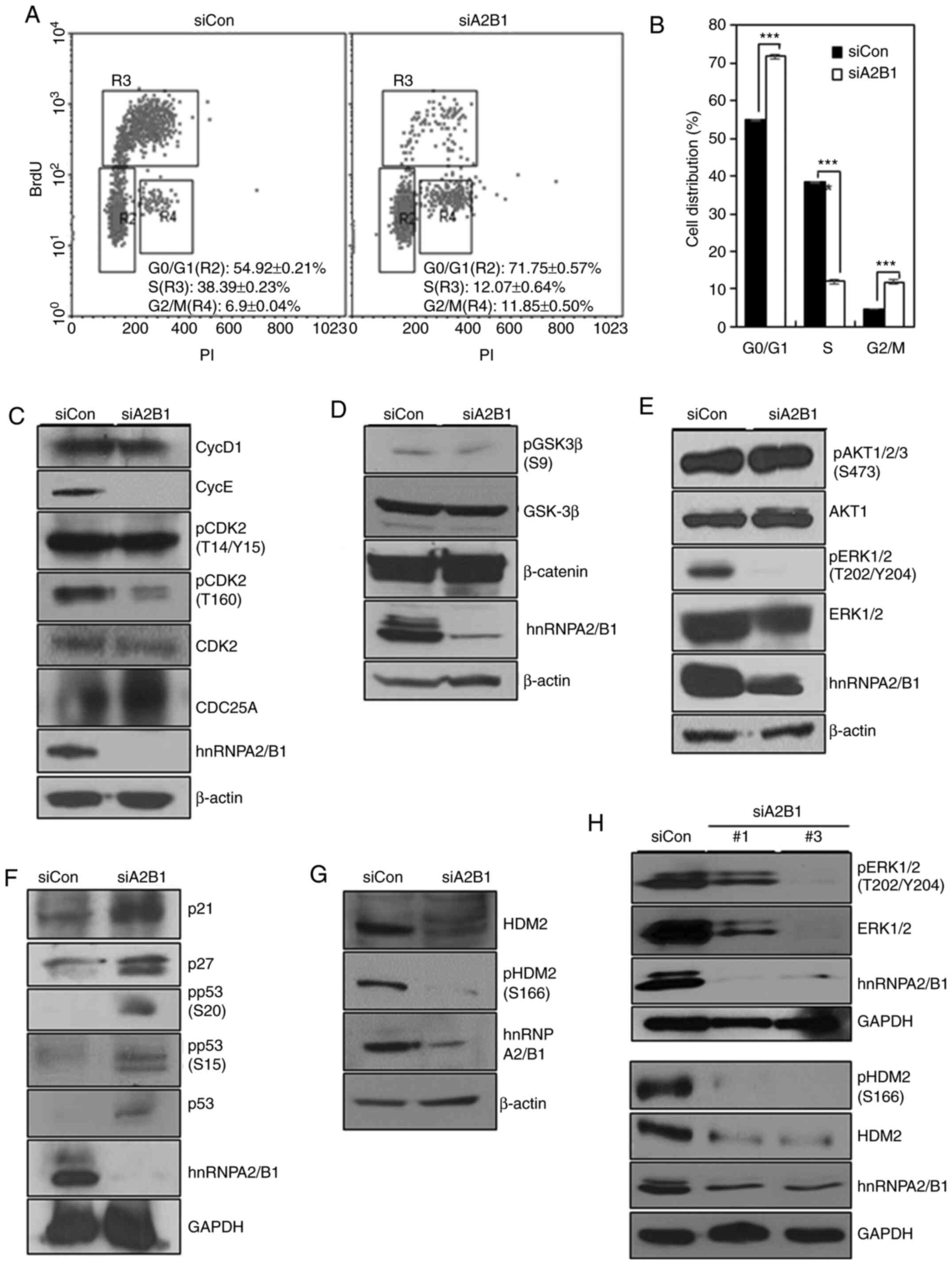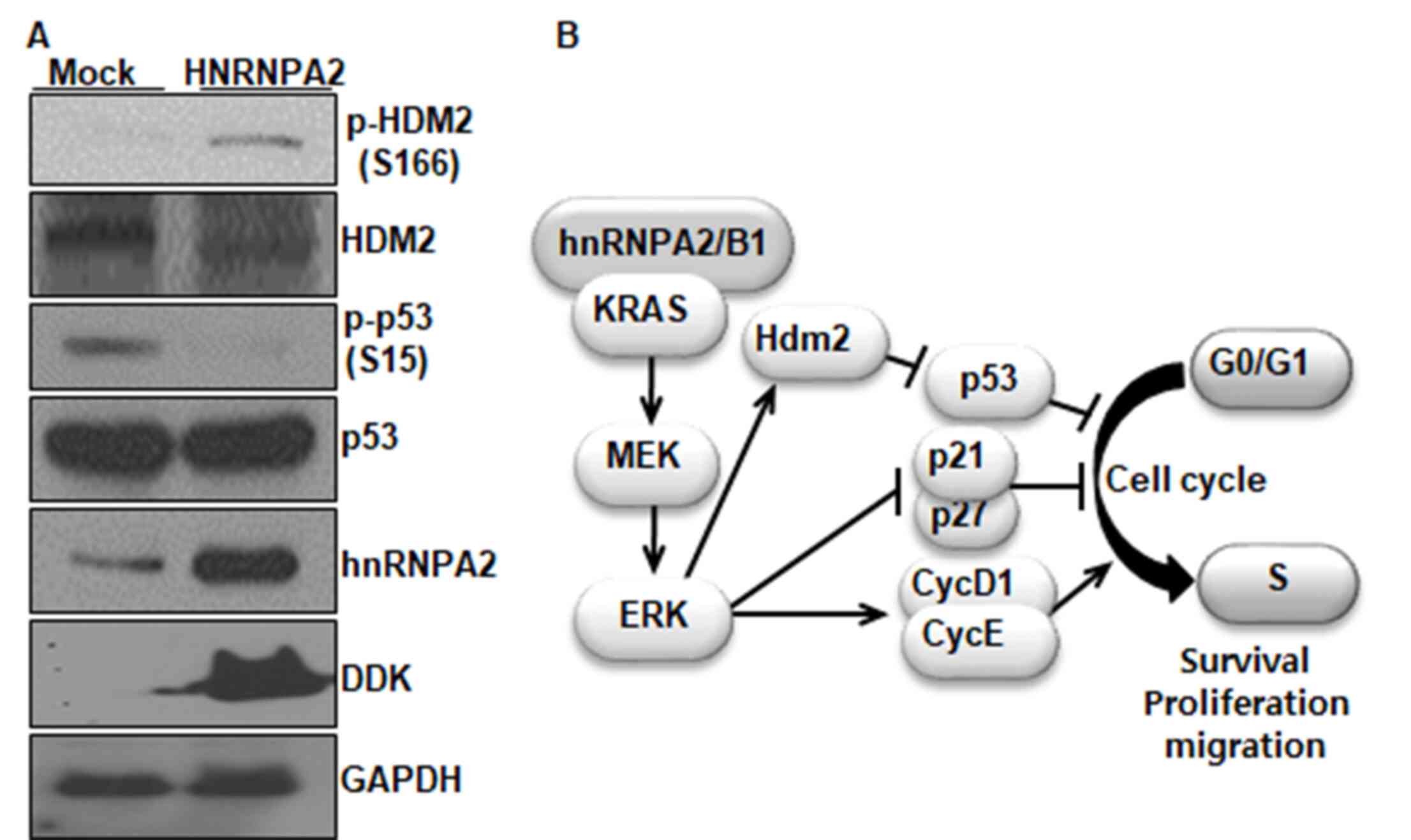|
1
|
Bray F, Ferlay J, Soerjomataram I, Siegel
RL, Torre LA and Jemal A: Global cancer statistics 2018: GLOBOCAN
estimates of incidence and mortality worldwide for 36 cancers in
185 countries. CA Cancer J Clin. 68:394–424. 2018. View Article : Google Scholar : PubMed/NCBI
|
|
2
|
Planchard D, Popat S, Kerr K, Novello S,
Smit EF, Faivre-Finn C, Mok TS, Reck M, Van Schil PE, Hellmann MD,
et al: Metastatic non-small cell lung cancer: ESMO Clinical
Practice Guidelines for diagnosis, treatment and follow-up. Ann
Oncol. 29:iv192–iv237. 2018. View Article : Google Scholar : PubMed/NCBI
|
|
3
|
Aran V and Omerovic J: Current approaches
in NSCLC targeting K-RAS and EGFR. Int J Mol Sci. 20:57012019.
View Article : Google Scholar : PubMed/NCBI
|
|
4
|
Siegel RL, Miller KD and Jemal A: Cancer
statistics, 2016. CA Cancer J Clin. 66:7–30. 2016. View Article : Google Scholar : PubMed/NCBI
|
|
5
|
Kozu T, Henrich B and Schafer KP:
Structure and expression of the gene (HNRPA2B1) encoding the human
hnRNP protein A2/B1. Genomics. 25:365–371. 1995. View Article : Google Scholar : PubMed/NCBI
|
|
6
|
Goodarzi H, Najafabadi HS, Oikonomou P,
Greco TM, Fish L, Salavati R, Cristea IM and Tavazoie S: Systematic
discovery of structural elements governing stability of mammalian
messenger RNAs. Nature. 485:264–268. 2012. View Article : Google Scholar : PubMed/NCBI
|
|
7
|
He Y, Rothnagel JA, Epis MR, Leedman PJ
and Smith R: Downstream targets of heterogeneous nuclear
ribonucleoprotein A2 mediate cell proliferation. Mol Carcinog.
48:167–179. 2009. View
Article : Google Scholar : PubMed/NCBI
|
|
8
|
David CJ, Chen M, Assanah M, Canoll P and
Manley JL: HnRNP proteins controlled by c-Myc deregulate pyruvate
kinase mRNA splicing in cancer. Nature. 463:364–368. 2010.
View Article : Google Scholar : PubMed/NCBI
|
|
9
|
Moran-Jones K, Grindlay J, Jones M, Smith
R and Norman JC: hnRNP A2 regulates alternative mRNA splicing of
TP53INP2 to control invasive cell migration. Cancer Res.
69:9219–9227. 2009. View Article : Google Scholar : PubMed/NCBI
|
|
10
|
Villarroya-Beltri C, Gutierrez-Vazquez C,
Sanchez-Cabo F, Pérez-Hernández D, Vázquez J, Martin-Cofreces N,
Martinez-Herrera DJ, Pascual-Montano A, Mittelbrunn M and
Sánchez-Madrid F: Sumoylated hnRNPA2B1 controls the sorting of
miRNAs into exosomes through binding to specific motifs. Nat
Commun. 4:29802013. View Article : Google Scholar : PubMed/NCBI
|
|
11
|
Geissler R, Simkin A, Floss D, Patel R,
Fogarty EA, Scheller J and Grimson A: A widespread
sequence-specific mRNA decay pathway mediated by hnRNPs A1 and
A2/B1. Genes Dev. 30:1070–1085. 2016. View Article : Google Scholar : PubMed/NCBI
|
|
12
|
Humphries F and Fitzgerald KA: hnRNPA2B1:
Fueling antiviral immunity from the nucleus. Mol Cell. 76:8–10.
2019. View Article : Google Scholar : PubMed/NCBI
|
|
13
|
Wu S, Sato M, Endo C, Sakurada A, Dong B,
Aikawa H, Chen Y, Okada Y, Matsumura Y, Sueoka E and Kondo T: hnRNP
B1 protein may be a possible prognostic factor in squamous cell
carcinoma of the lung. Lung Cancer. 41:179–186. 2003. View Article : Google Scholar : PubMed/NCBI
|
|
14
|
Ushigome M, Ubagai T, Fukuda H, Tsuchiya
N, Sugimura T, Takatsuka J and Nakagama H: Up-regulation of hnRNP
A1 gene in sporadic human colorectal cancers. Int J Oncol.
26:635–640. 2005.PubMed/NCBI
|
|
15
|
Zhou J, Allred DC, Avis I, Martínez A, Vos
MD, Smith L, Treston AM and Mulshine JL: Differential expression of
the early lung cancer detection marker, heterogeneous nuclear
ribonucleoprotein-A2/B1 (hnRNP-A2/B1) in normal breast and
neoplastic breast cancer. Breast Cancer Res Treat. 66:217–224.
2001. View Article : Google Scholar : PubMed/NCBI
|
|
16
|
Yan-Sanders Y, Hammons GJ and Lyn-Cook BD:
Increased expression of heterogeneous nuclear ribonucleoprotein
A2/B1 (hnRNP) in pancreatic tissue from smokers and pancreatic
tumor cells. Cancer Lett. 183:215–220. 2002. View Article : Google Scholar : PubMed/NCBI
|
|
17
|
Lee CH, Lum JH, Cheung BP, Wong MS, Butt
YK, Tam MF, Chan WY, Chow C, Hui PK, Kwok FS, et al: Identification
of the heterogeneous nuclear ribonucleoprotein A2/B1 as the antigen
for the gastrointestinal cancer specific monoclonal antibody MG7.
Proteomics. 5:1160–1166. 2005. View Article : Google Scholar : PubMed/NCBI
|
|
18
|
Jing GJ, Xu DH, Shi SL, Li QF, Wang SY, Wu
FY and Kong HY: Aberrant expression and localization of hnRNP-A2/B1
is a common event in human gastric adenocarcinoma. J Gastroenterol
Hepatol. 26:108–115. 2011. View Article : Google Scholar : PubMed/NCBI
|
|
19
|
Liang Y, Shi SL, Li QF, Chen LY, Jing GJ,
Tan GW, Wang SY and Wu FY: The localization of hnRNP A2/B1 in
nuclear matrix and the aberrant expression during the RA-induced
differentiation of human neuroblastoma SK-N-SH cells. J Cell
Biochem. 112:1722–1729. 2011. View Article : Google Scholar : PubMed/NCBI
|
|
20
|
Mizuno H, Honda M, Shirasaki T, Yamashita
T, Yamashita T, Mizukoshi E and Kaneko S: Heterogeneous nuclear
ribonucleoprotein A2/B1 in association with hTERT is a potential
biomarker for hepatocellular carcinoma. Liver Int. 32:1146–1155.
2012. View Article : Google Scholar : PubMed/NCBI
|
|
21
|
Barcelo C, Etchin J, Mansour MR, Sanda T,
Ginesta MM, Sanchez-Arévalo Lobo VJ, Real FX, Capellà G, Estanyol
JM, Jaumot M, et al: Ribonucleoprotein HNRNPA2B1 interacts with and
regulates oncogenic KRAS in pancreatic ductal adenocarcinoma cells.
Gastroenterology. 147:882–892.e8. 2014. View Article : Google Scholar : PubMed/NCBI
|
|
22
|
Hu Y, Sun Z, Deng J, Hu B, Yan W, Wei H
and Jiang J: Splicing factor hnRNPA2B1 contributes to tumorigenic
potential of breast cancer cells through STAT3 and ERK1/2 signaling
pathway. Tumour Biol. 39:10104283176943182017. View Article : Google Scholar : PubMed/NCBI
|
|
23
|
Liu Y, Li H, Liu F, Gao LB, Han R, Chen C,
Ding X, Li S, Lu K, Yang L, et al: Heterogeneous nuclear
ribonucleoprotein A2/B1 is a negative regulator of human breast
cancer metastasis by maintaining the balance of multiple genes and
pathways. EBioMedicine. 51:1025832020. View Article : Google Scholar : PubMed/NCBI
|
|
24
|
Sueoka E, Goto Y, Sueoka N, Kai Y, Kozu T
and Fujiki H: Heterogeneous nuclear ribonucleoprotein B1 as a new
marker of early detection for human lung cancers. Cancer Res.
59:1404–1407. 1999.PubMed/NCBI
|
|
25
|
Katsimpoula S, Patrinou-Georgoula M,
Makrilia N, Dimakou K, Guialis A, Orfanidou D and Syrigos KN:
Overexpression of hnRNPA2/B1 in bronchoscopic specimens: A
potential early detection marker in lung cancer. Anticancer Res.
29:1373–1382. 2009.PubMed/NCBI
|
|
26
|
Tauler J, Zudaire E, Liu H, Shih J and
Mulshine JL: hnRNP A2/B1 modulates epithelial-mesenchymal
transition in lung cancer cell lines. Cancer Res. 70:7137–7147.
2010. View Article : Google Scholar : PubMed/NCBI
|
|
27
|
Choi HS, Lee HM, Jang YJ, Kim CH and Ryu
CJ: Heterogeneous nuclear ribonucleoprotein A2/B1 regulates the
self-renewal and pluripotency of human embryonic stem cells via the
control of the G1/S transition. Stem Cells. 31:2647–2658. 2013.
View Article : Google Scholar : PubMed/NCBI
|
|
28
|
Seo SR, Lee HM, Choi HS, Kim WT, Cho EW
and Ryu CJ: Enhanced expression of cell-surface B-cell
receptor-associated protein 31 contributes to poor survival of
non-small cell lung carcinoma cells. PLoS One. 12:e01880752017.
View Article : Google Scholar : PubMed/NCBI
|
|
29
|
Choi HS, Kim H, Won A, Kim JJ, Son CY, Kim
KS, Ko JH, Lee MY, Kim CH and Ryu CJ: Development of a decoy
immunization strategy to identify cell-surface molecules expressed
on undifferentiated human embryonic stem cells. Cell Tissue Res.
333:197–206. 2008. View Article : Google Scholar : PubMed/NCBI
|
|
30
|
Lee HM, Seo SR, Kim J, Kim MK, Seo H, Kim
KS, Jang YJ and Ryu CJ: Expression dynamics of integrin α2, α3, and
αV upon osteogenic differentiation of human mesenchymal stem cells.
Stem Cell Res Ther. 11:2102020. View Article : Google Scholar : PubMed/NCBI
|
|
31
|
Livak KJ and Schmittgen TD: Analysis of
relative gene expression data using real-time quantitative PCR and
the 2(-Delta Delta C(T)) method. Methods. 25:402–408. 2001.
View Article : Google Scholar : PubMed/NCBI
|
|
32
|
Lee HM, Joh JW, Seo SR, Kim WT, Kim MK,
Choi HS, Kim SY, Jang YJ, Sinn DH, Choi GS, et al: Cell-surface
major vault protein promotes cancer progression through harboring
mesenchymal and intermediate circulating tumor cells in
hepatocellular carcinomas. Sci Rep. 7:132012017. View Article : Google Scholar : PubMed/NCBI
|
|
33
|
Shibue T and Weinberg RA: EMT, CSCs, and
drug resistance: The mechanistic link and clinical implications.
Nat Rev Clin Oncol. 14:611–629. 2017. View Article : Google Scholar : PubMed/NCBI
|
|
34
|
He Y, Brown MA, Rothnagel JA, Saunders NA
and Smith R: Roles of heterogeneous nuclear ribonucleoproteins A
and B in cell proliferation. J Cell Sci. 118:3173–3183. 2005.
View Article : Google Scholar : PubMed/NCBI
|
|
35
|
Shi X, Ran L, Liu Y, Zhong SH, Zhou PP,
Liao MX and Fang W: Knockdown of hnRNP A2/B1 inhibits cell
proliferation, invasion and cell cycle triggering apoptosis in
cervical cancer via PI3K/AKT signaling pathway. Oncol Rep.
39:939–950. 2018.PubMed/NCBI
|
|
36
|
Sherr CJ and Roberts JM: CDK inhibitors:
Positive and negative regulators of G1-phase progression. Genes
Dev. 13:1501–1512. 1999. View Article : Google Scholar : PubMed/NCBI
|
|
37
|
Toledo F and Wahl GM: Regulating the p53
pathway: In vitro hypotheses, in vivo veritas. Nat Rev Cancer.
6:909–923. 2006. View Article : Google Scholar : PubMed/NCBI
|
|
38
|
Gurtner K, Kryzmien Z, Koi L, Wang M,
Benes CH, Hering S, Willers H, Baumann M and Krause M:
Radioresistance of KRAS/TP53-mutated lung cancer can be overcome by
radiation dose escalation or EGFR tyrosine kinase inhibition in
vivo. Int J Cancer. 147:472–477. 2020. View Article : Google Scholar : PubMed/NCBI
|
|
39
|
Chen CY, Jan CI, Pi WC, Wang WL, Yang PC,
Wang TH, Karni R and Wang TC: Heterogeneous nuclear
ribonucleoproteins A1 and A2 modulate expression of Tid1 isoforms
and EGFR signaling in non-small cell lung cancer. Oncotarget.
7:16760–16772. 2016. View Article : Google Scholar : PubMed/NCBI
|
|
40
|
Dai S, Zhang J, Huang S, Lou B, Fang B, Ye
T, Huang X, Chen B and Zhou M: HNRNPA2B1 regulates the
epithelial-mesenchymal transition in pancreatic cancer cells
through the ERK/snail signalling pathway. Cancer Cell Int.
17:122017. View Article : Google Scholar : PubMed/NCBI
|
|
41
|
Zhou ZJ, Dai Z, Zhou SL, Hu ZQ, Chen Q,
Zhao YM, Shi YH, Gao Q, Wu WZ, Qiu SJ, et al: HNRNPAB induces
epithelial-mesenchymal transition and promotes metastasis of
hepatocellular carcinoma by transcriptionally activating SNAIL.
Cancer Res. 74:2750–2762. 2014. View Article : Google Scholar : PubMed/NCBI
|
|
42
|
Stockley J, Villasevil ME, Nixon C, Ahmad
I, Leung HY and Rajan P: The RNA-binding protein hnRNPA2 regulates
β-catenin protein expression and is overexpressed in prostate
cancer. RNA Biol. 11:755–765. 2014. View Article : Google Scholar : PubMed/NCBI
|


















